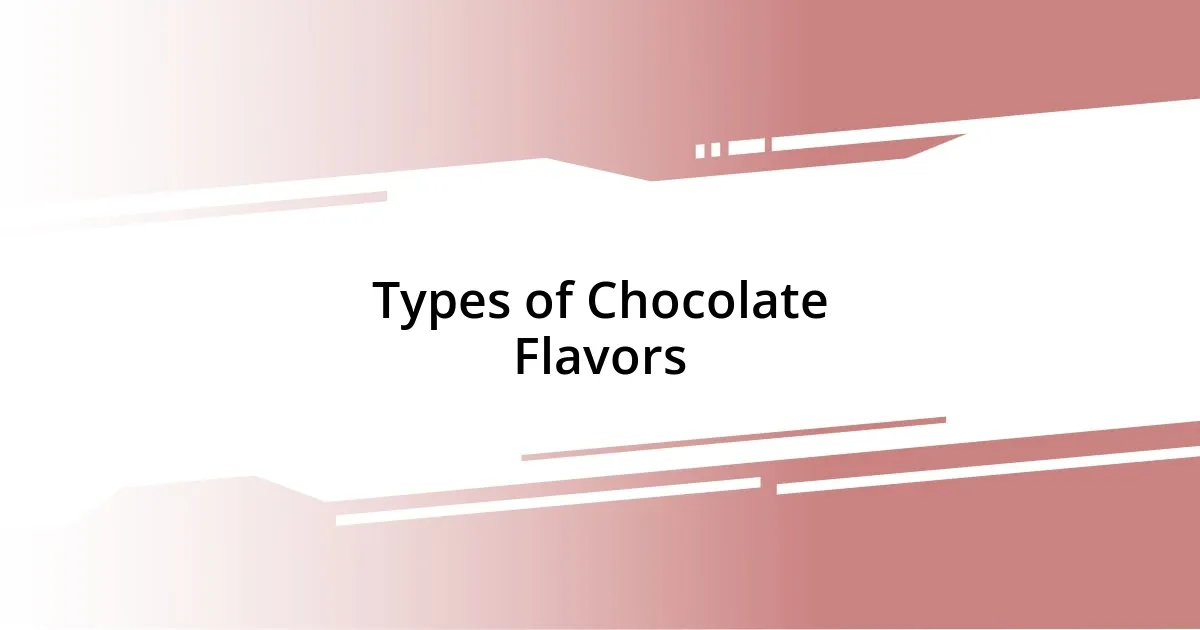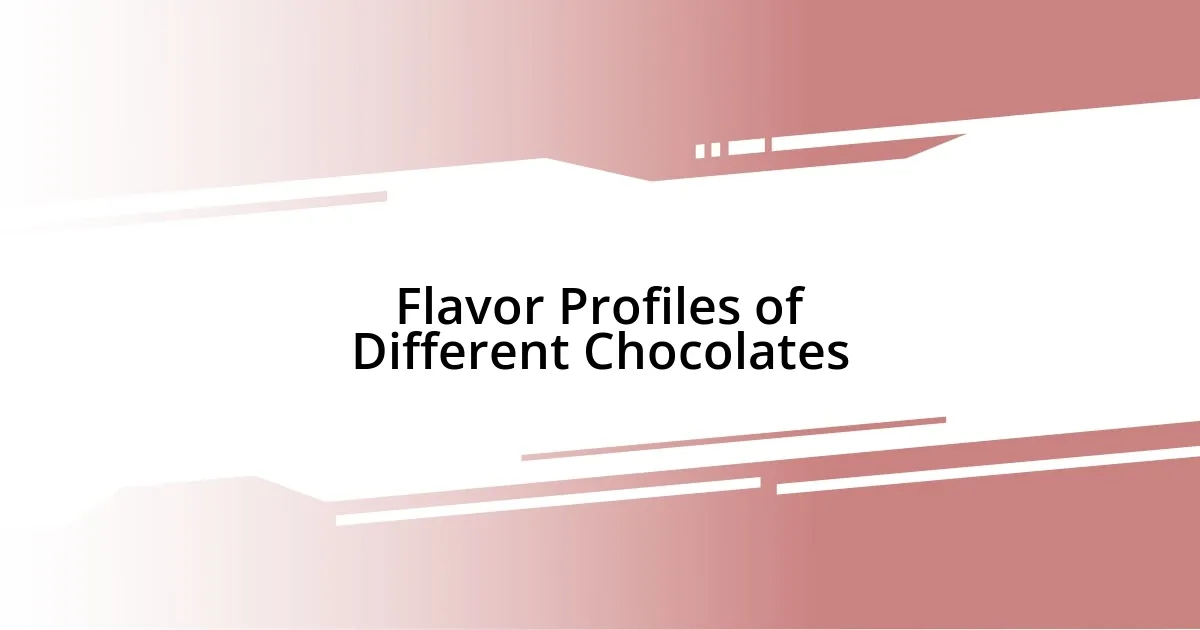Key takeaways:
- Chocolate pairings can dramatically enhance the flavor experience, such as combining dark chocolate with red wine or sea salt and caramel.
- Different types of chocolate (dark, milk, white, ruby) evoke unique flavors and emotional connections, influenced by personal preferences and seasonal changes.
- Complementary food pairings, like chocolate with nuts or citrus fruits, create unexpected layers of flavor while enhancing the tasting experience.
- Experimenting with spices and herbs, such as cayenne pepper or rosemary, can transform chocolate enjoyment by introducing new flavor dimensions.

Understanding Chocolate Pairings
When I first delved into the world of chocolate pairings, I was surprised by how much a single flavor can transform the chocolate experience. Imagine biting into a rich dark chocolate while sipping on a well-aged red wine. The complexity of the wine can enhance the cocoa’s deep notes, creating a symphony of flavors that made my taste buds dance.
I remember one evening, I decided to pair chocolate with sea salt and caramel. The rush of flavors; the sweetness mingling with buttery richness and a hint of salt, was nothing short of magical. This combination taught me that contrasting elements can beautifully highlight the nuanced qualities of the chocolate itself. Have you ever tried something like that? That contrast often brings out flavors I never even realized were there.
As I explored different pairings, I found that personal preferences played a huge role. Some people love spicy notes, while others may prefer fruity accents with their chocolate. It’s fascinating to see how individual experiences shape our tastes. Every chocolate pairing is a journey, and I’ve learned that sharing these experiences adds an emotional layer to enjoying chocolate. Isn’t it wonderful how something as simple as chocolate can connect us on such a deep level?

Types of Chocolate Flavors
When exploring types of chocolate flavors, I realized that each type brings a unique character to the table. For instance, the bitterness of dark chocolate can be incredibly satisfying, especially when paired with a bold cup of coffee. I recall a cozy afternoon where I savored a 70% cacao chocolate bar while sipping an espresso. The experience was a delicious reminder of how dark chocolate has the power to evoke a deep sense of comfort and warmth within me.
- Dark Chocolate: Rich and intense, often with notes of berry or coffee.
- Milk Chocolate: Creamy and sweet, frequently highlighting caramel or vanilla undertones.
- White Chocolate: Not technically chocolate but sweet and buttery, with hints of cream and sometimes citrus.
- Ruby Chocolate: A newer addition, it showcases tangy berry notes while retaining smooth sweetness.
- Flavored Chocolates: Including additions like chili, mint, or sea salt, these vary widely and can surprise the palate with their complexity.
Each type has its own story and resonates differently with those who partake in it. I find that seasonal influences can alter my preferences—during the colder months, heartier flavors like rich dark chocolate become comforting, while in warmer weather, the lightness of white chocolate can feel refreshing. It’s fascinating how chocolate, in all its varieties, offers an emotional connection that reflects our personal experiences and memories.

Complementary Food Pairings
Complementary food pairings can elevate the chocolate experience in unexpected ways. I once experimented with dark chocolate and freshly toasted nuts—a blend that truly captivated my taste buds. The crunch of the nuts alongside the smooth richness of the chocolate offered a delightful contrast that kept me reaching for more. It’s amazing how simple additions can create layers of flavor that enhance both ingredients.
One pairing that has consistently surprised me is chocolate with citrus fruits. Imagine the Zestiness of orange or the tartness of raspberry dancing in harmony with dark chocolate; it’s like a little fiesta for your mouth! I remember trying a luxurious chocolate truffle infused with orange peel. The bright notes cut through the chocolate’s richness, making each bite feel refreshing rather than heavy. Have you ever discovered a flavor combination that transformed the way you see chocolate?
Additionally, cheese can harmoniously complement chocolate. The creaminess of a soft brie or the sharpness of aged gouda can transform the tasting experience. I vividly recall a cheese and chocolate tasting event where different combinations left me in awe. It was surprising to find flavors pairing so beautifully, enhancing the complexities of each bite. These complementary pairings offer a world of flavor exploration that can make each chocolate experience uniquely memorable.
| Chocolate Type | Complementary Pairing |
|---|---|
| Dark Chocolate | Toasted Nuts |
| Dark Chocolate | Citrus Fruits |
| Milk Chocolate | Cheese (Brie or Gouda) |
| White Chocolate | Fresh Berries |

Matching Wine with Chocolate
Matching wine with chocolate can be a delightful adventure, as the right combination can enhance both elements beautifully. I distinctly remember a tasting evening where I paired red wine with deep, rich dark chocolate. The wine’s bold tannins danced perfectly with the chocolate’s bitterness, creating a symphony of flavors. Have you ever experienced that moment when two tastes collide and create something extraordinary?
When it comes to milk chocolate, I find that a sweeter white wine often does wonders. The luscious creaminess of the chocolate becomes even more indulgent when sipped alongside a chilled Riesling. I had a memorable moment sharing this pairing with friends; everyone’s eyes lit up as the sweet flavor profile unfolded. It was like finding the missing puzzle piece to our dessert plan!
Then there’s the surprising pair of sparkling wine with chocolate. I remember discovering this unexpected match at a local winery—pairing a rich chocolate mousse with a sparkling rosé. The bubbles and acidity cut through the velvety texture, providing a refreshing contrast that left me craving more. Have you tried matching a bubbly wine with chocolate? If not, I highly recommend giving it a go for a truly delightful experience.

Experimenting with Spices and Herbs
Experimenting with spices and herbs in chocolate pairings opens up a world of flavor possibilities. I still remember the first time I added a sprinkle of sea salt and a pinch of cayenne pepper to my dark chocolate. The heat from the cayenne complemented the rich cocoa perfectly, creating an unexpected warmth that lingered on my palate. It made me wonder—have you ever considered how a little spice can completely transform your experience of chocolate?
One delightful experiment involved infusing chocolate with aromatic herbs like rosemary and basil. The first time I tasted dark chocolate with rosemary, it was as if the flavors were dancing in perfect harmony. The earthy notes of the herb added an intriguing complexity that got me thinking about the possibilities of using other herbs. Have you tried mixing chocolate with fresh herbs? I strongly encourage this unexpected combination; it’s like embarking on a flavor journey that surprises at every turn.
One spice I keep returning to is cinnamon; it has an incredible ability to meld with chocolate’s sweetness. I recall making spiced hot chocolate, adding just a hint of cinnamon. The result was a warm, comforting drink that felt like a hug in a mug. The aromatic quality of cinnamon brought an entirely new dimension to the chocolate experience. It really got me thinking—what other spices might I be overlooking that could elevate this beloved treat? So many spices are waiting to be discovered alongside chocolate!

Flavor Profiles of Different Chocolates
The flavor profiles of different chocolates can be quite fascinating, each variety offering a unique experience. For instance, I vividly recall tasting a single-origin dark chocolate from Madagascar, which had bright, fruity notes reminiscent of cherries and citrus. It was a refreshing surprise to experience those zesty flavors alongside the usual richness of dark chocolate—has anyone else been taken aback by a chocolate that was so far from their expectations?
On the other hand, the creaminess of milk chocolate draws out a different spectrum of flavors, often leaning towards caramel or toffee. I remember indulging in a milk chocolate truffle infused with espresso—what a delightful combination! The coffee’s bitterness played beautifully against the smoothness of the chocolate, igniting an invigorating dance on my taste buds. It’s moments like these that make you realize how understanding different flavor profiles can truly enhance your enjoyment of chocolate.
I find white chocolate offers its own, often maligned character, primarily due to its sweetness. It’s more of a canvas than a standalone flavor for me. Once, I enjoyed a white chocolate bar with matcha, and the earthy green tea notes brought an unexpected balance to the rich sweetness. It made me question—how many flavors have I overlooked in my chocolate journey simply because I didn’t take the time to explore beyond conventional pairings?













